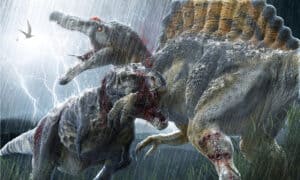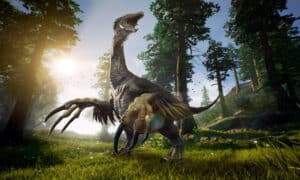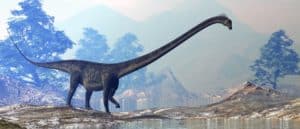More than 1,000 species of dinosaurs once inhabited various regions around the world, gracing the Earth for a substantial 165 million years. Sadly, their presence ceased about 65 million years ago. In this article, we journey back to that distant era, focusing on the dinosaurs whose names begin with the letter A. So, let’s venture into the past with this carefully curated list that highlights the unique characteristics and histories of these reptiles!
1. Ahshislepelta
The first dinosaur on our list that starts with A is the Ahshislepelta. The Ahshislepelta was a unique type of ankylosaur dinosaur in New Mexico during the latter part of the Cretaceous period.
In a 2011 study, Burns & Sullivan pinpointed distinguishing features of ahshislepelta, highlighting the particular projection of its shoulder blade’s acromion process, which extends over 25% of the blade’s vertical width. This dinosaur stands out among other members of the ankylosaur family, with the exception being Euoplocephalus, owing to its distinct skin surface texture. The skin had a consistent pattern of shallow depressions and a scattered arrangement of network-like neurovascular channels. These channels and small holes extend in various directions into the bone.
This dinosaur primarily fed on plants, but the exact size remains unknown since only a single specimen has been uncovered by paleontologists so far.
The name Ahshislepelta has its roots in the place where paleontologists discovered the first specimen, the Ah-shi-sle-pah Wash, coupled with the Greek word “peltè”, which means shield.
2. Apatodon
Another dinosaur that starts with A, Apatodon is a dinosaur genus that remains uncertain and likely invalid, primarily known from a single, now-lost vertebra.
Initially, experts believed it was a toothed jawbone from a pig-like creature that lived during the Mesozoic era. However, it was later clarified that the specimen was actually a worn-down dinosaur vertebra, possibly originating from the Morrison Formation located in Garden Park, Colorado.
Unfortunately, the one specimen that was found doesn’t provide enough evidence to categorize it as a specific dinosaur species. Nonetheless, George Olshevsky proposed that apatodon might be another name for the well-known dinosaur, Allosaurus fragilis. This theory cannot be further investigated since the primary bone fragment is now missing.
The name Apatodon comes from Greek words meaning “deception” and “tooth”, which is a nod to its initial misidentification.
3. Aucasaurus
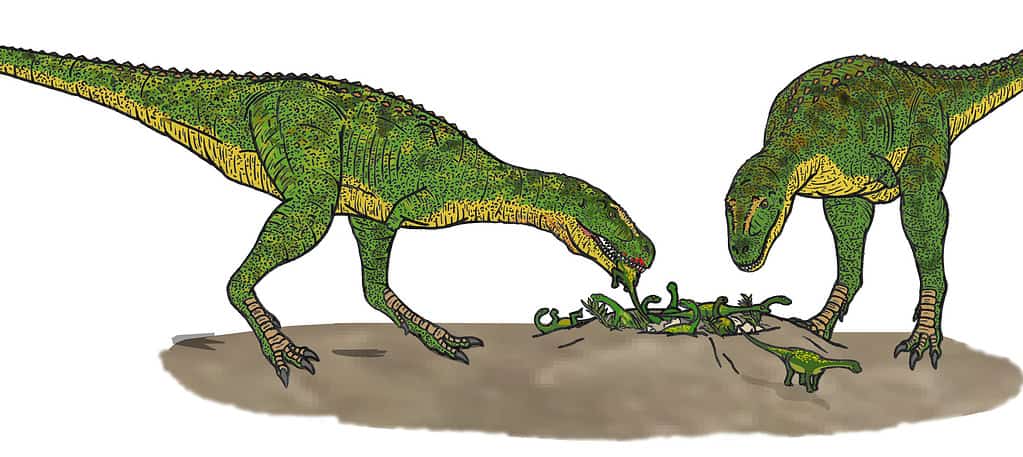
A moderately-sized dinosaur, the
Aucasauruslived during the Late Cretaceous period.
©Conty / CC BY 3.0 – License
Aucasaurus hailed from the abelisaurid family and inhabited the regions of Argentina during the Late Cretaceous period.
Though not vastly recognized in mainstream circles, aucasaurus holds a prominent position in the field of paleontology due to possessing the most complete skeleton found within its family of dinosaurs.
Its discovery traces back to 1999 in Argentina, but it wasn’t until later that it received its official designation by the trio of paleontologists: Coria, Chiappe, and Dingus. They chose the name Aucasaurus, which translates to “Auca lizard,” referencing the area where it was originally unearthed.
Aucasaurus was a carnivorous dinosaur of moderate size, with an estimated length of 18 to 20 feet and a weight nearing 1,500 pounds.
In terms of physical features, its head structure differed significantly from the Carnotaurus, another member of its family. Its face was not as compact or prominently snouted. Instead of brandishing horns, it showcased low bone ridges above each eye.
While its arms resembled those of its horned counterpart, they were relatively longer considering its smaller stature, lacking the peculiar bone processes and proportions seen in the Carnotaurus. An interesting aspect of the Aucasaurus was its hands, characterized by four metacarpal bones (also known as the palm bones); however, only the middle two were accompanied by shortened fingers without claws, leaving the first and fourth metacarpals without fingers.
4. Albertadromeus
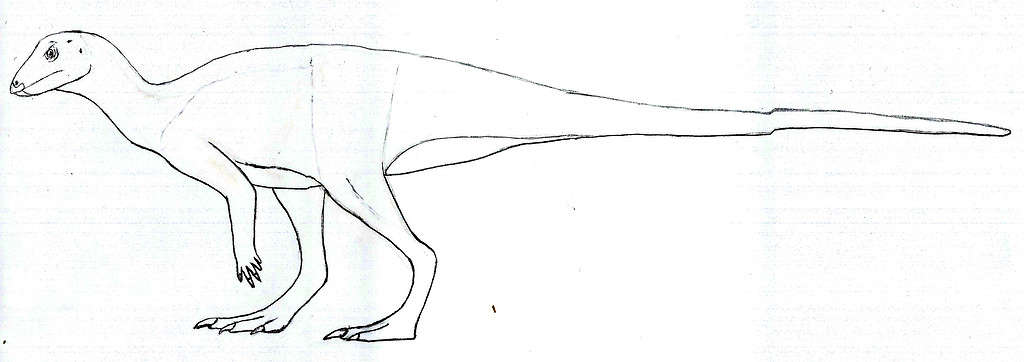
Found in Canada, the
Albertadromeuswas the smallest herbivore.
©Levi bernardo / CC BY-SA 3.0 – License
Albertadromeus was a type of swift-footed herbivorous dinosaur belonging to the orodromine thescelosaurid family, which resided in the region of Alberta, Canada, during the later stages of the Cretaceous period.
The name Albertadromeus combines the province’s name, Alberta, with the Greek term dromeus, which translates to “runner,” aptly highlighting its presumed swift nature and dubbing it as the “runner from Alberta.”
Among the dinosaurs in its habitat, it was the smallest herbivore, with researchers suggesting that its speed might have been a defense mechanism to evade the numerous carnivorous dinosaurs existing during its era.
Being around 5 feet long and tipping the scales at roughly 30 pounds, somewhat similar to that of a hefty turkey.
5. Alioramus
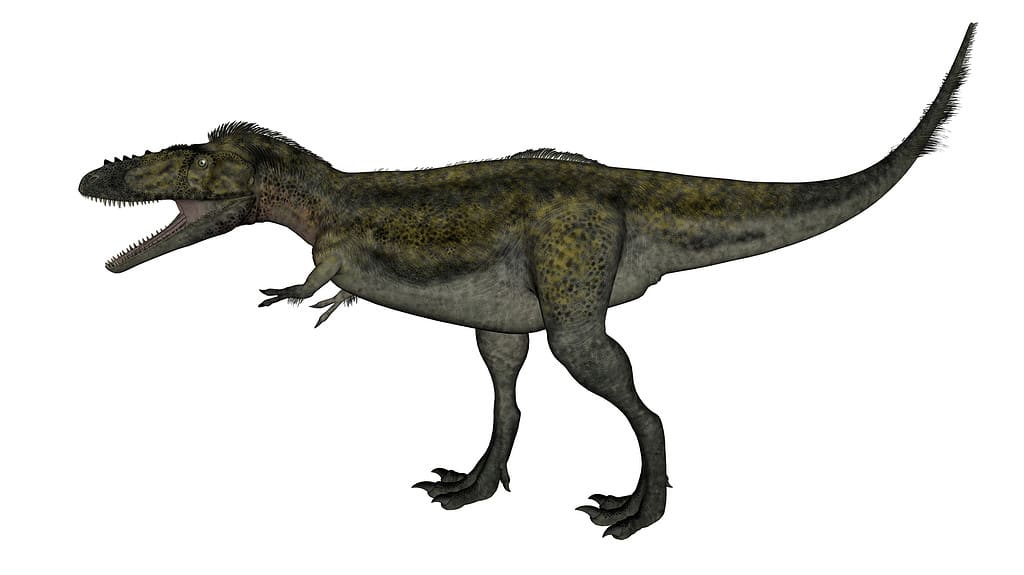
As a tyrannosaurid therapod, the
Alioramuswalked on two legs.
©Elenarts108/iStock via Getty Images
Alioramus is a genus of tyrannosaurid theropod dinosaurs that inhabited Asia during the Late Cretaceous period. The primary species, A. remotus, has been identified through a fragmentary skull and a trio of foot bones found in Mongolia.
Like other known theropods, Alioramus walked on two legs, and their pointed teeth are evidence of their carnivorous diet. Remarkably, their mouths had about 78 fierce, dagger-like teeth, a number surpassing other tyrannosaurs.
The credit for naming and detailing this dinosaur goes to Russian paleontologist Sergei Kurzanov in 1976. Due to its distinctive crests and lower skull structure, which were markedly different from fellow tyrannosaurids, Kurzanov reasoned that this discovery was significantly distinct from other family members.
Thus, he named it Alioramus, a term that blends Latin words meaning “other” and “branch,” along with the species name A. remotus, which translates to “removed” in Latin, reflecting its distinct characteristics.
6. Aggiosaurus
Aggiosaurus represents an extinct genus that thrived during the Late Jurassic period, specifically in the late Oxfordian stage, in the southeastern part of France, near Nice. This genus is characterized by a lone species, Aggiosaurus nicaeensis, which was identified and documented by H. Ambayrac in 1913.
The sole evidence of the existence of Aggiosaurus is the type specimen, an unnumbered fragment of an upper jaw, which is not in the best condition. This relic, found by H. Ambayrac in 1912, is conserved in limestone and can be viewed at the Natural History Museum in Nice. Paleontologists found this fragment at a site located at Cap d’Aggio-La Turbie in Nice, France.
Initially, Ambayrac classified it as a member of the megalosaurid dinosaurs in 1913. However, further research by Buffetaut in 1982 revealed that it was actually more closely aligned with the metriorhynchids, potentially even being a variant of Dakosaurus.
The name of this genus is a combination of its discovery location, Cap d’Aggio-La Turbie, and the Ancient Greek term sauros, which means “lizard.” Its species name, nicaeensis, pays tribute to the city of Nice, France.
7. Acheroraptor
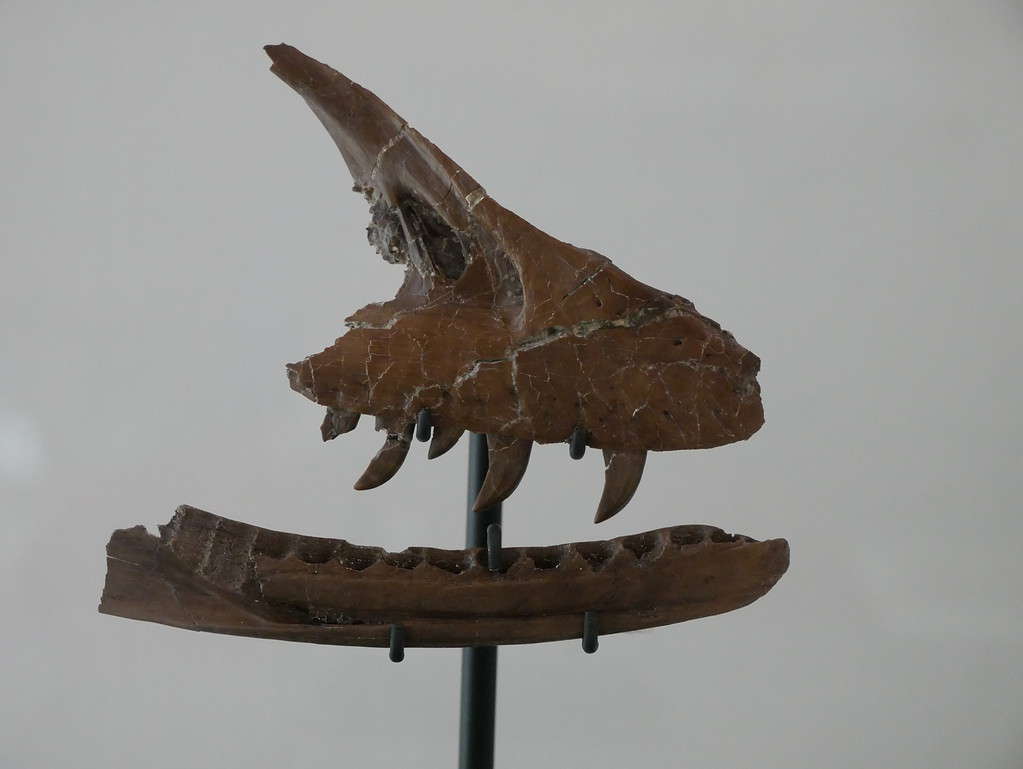
A dinosaur that starts with the letter A is the
Acheroraptor.
©Skye McDavid / CC BY 4.0 – License
Acheroraptor belonged to the dromaeosaurid group of theropod dinosaurs. It inhabited Montana in the USA during the later stages of the Cretaceous period. This genus is represented by a solitary species, Acheroraptor temertyorum.
This dinosaur was initially detailed and named by paleontologists David C. Evans, Derek W. Larson, and Philip J. Currie in 2013. Its name is a combination of the Greek word Acheron, which signifies “underworld” — a nod to its discovery location, the Hell Creek Formation — and the Latin word raptor, which means “thief.”
As one of the last dromaeosaurids to roam the earth, Acheroraptor existed around the same time as the Dakotaraptor, also found in Hell Creek. The dinosaur was of moderate size, measuring roughly between 6 and 10 feet long and about 2 to 3 feet tall, with an approximate weight range of 40 to 88 pounds.
As a carnivorous creature, Acheroraptor hunted and fed on small mammals, lizards, and small ornithischians. It had teeth with sharp edges resembling those of a knife, running along both sides, and it utilized its curved claw primarily to hold onto its prey tightly.
8. Anchisaurus
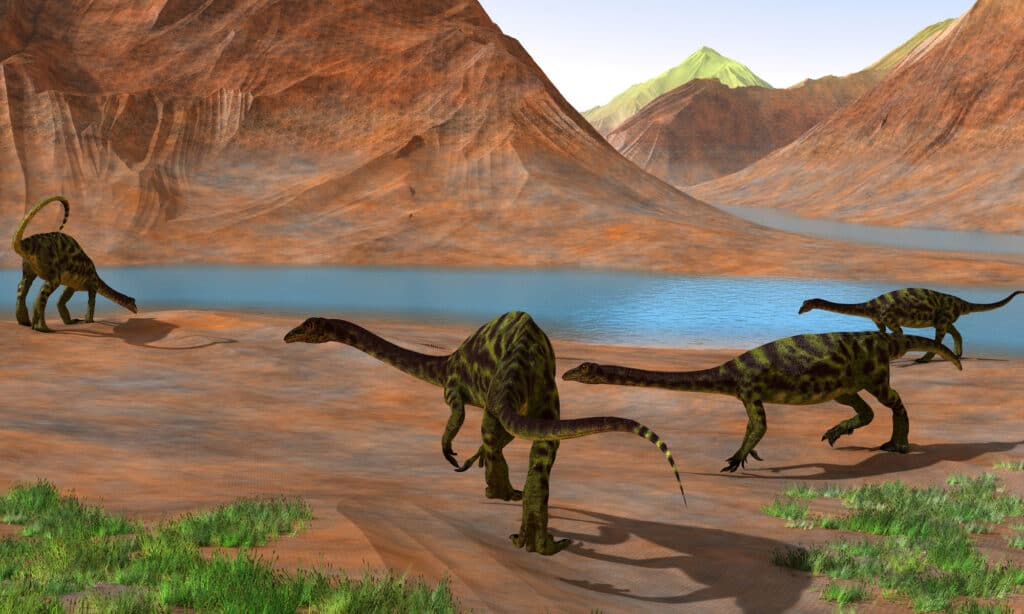
The bones of the
Anchisaurusalmost looked like human bones at first glance!
©iStock.com/CoreyFord
Anchisaurus was quite small compared to other prosauropods. This creature roamed the earth during the Early Jurassic period, leaving behind fossil remnants in the reddish-colored sandstone layers of the Portland Formation, located in the northeastern regions of the United States. The geological timeline of this habitat is marked from the Hettangian to the Sinemurian epochs, approximately 200 to 195 million years ago.
Spanning just a bit more than 6 feet, this dinosaur at one time confused some into thinking they were human remains. It could alternate between walking on two or all fours. Its hands had robust claws, a tool that aided in holding onto tree limbs, prying open tree trunks, or thwarting attackers. Being a plant-eater, it utilized gastric stones to facilitate the breakdown of food within its digestive system.
The genus name is derived from the Greek words agkhi or anchi-, meaning “near” or “close,” coupled with sauros, which means “lizard.” This terminology reflects Marsh’s hypothesis of the species being a transitional phase linking the most ancient dinosaurs to their evolved counterparts.
9. Arrhinoceratops
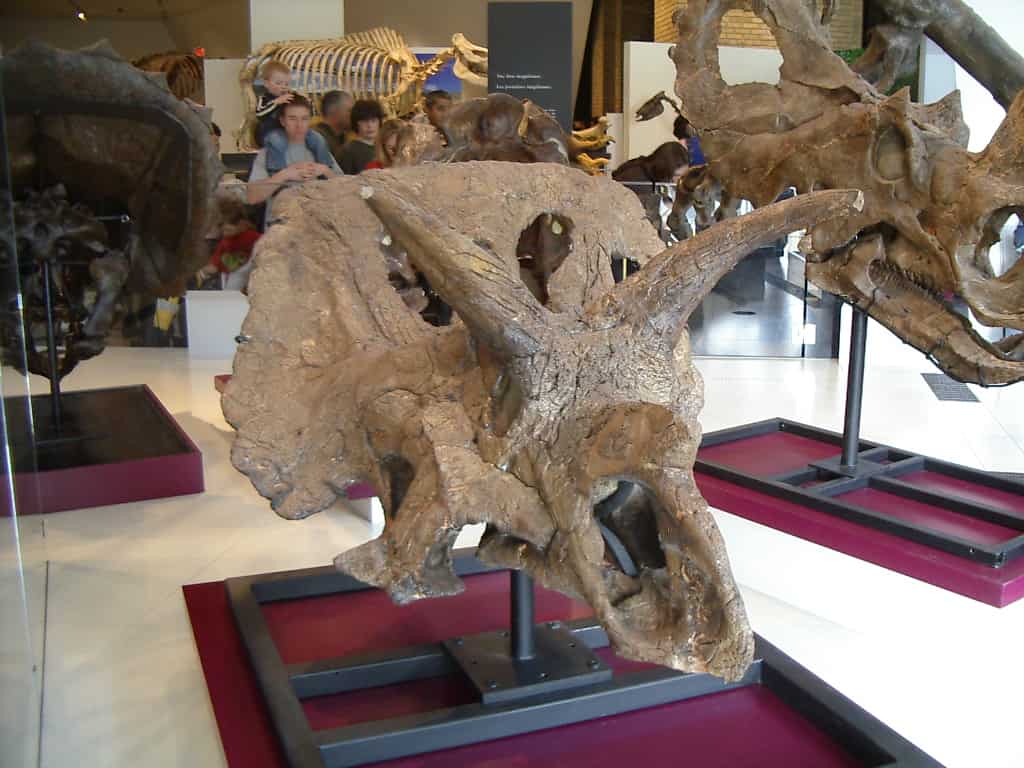
A part of the
ceratopsianfamily, the
Arrhinoceratopspossibly measured up to 20 feet long!
©Staka / CC BY-SA 4.0 – License
The Arrhinoceratops, which translates to “face without a nasal horn,” was initially named under the presumption that it lacked a horn on its nose. Subsequent research debunked this theory. This dinosaur roamed the earth during the initial stages of the Maastrichtian phase in the Late Cretaceous period. Paleontologists discovered its remains in Canada.
Given that only its skull remains have been found, there’s limited information about its complete physical structure. The skull is characterized by a wide neck frill that houses two elliptical holes. While it had quite elongated horns above its eyes, the nasal horn was comparatively shorter and more rounded than its ceratopsian counterparts. Judging by the skull, it’s believed that a fully matured individual would measure up to about 20 feet in length.
As a member of the ceratopsian family, the Arrhinoceratops was herbivorous. In its time, flowering plants were scarcely distributed across terrains, making it plausible that these dinosaurs primarily fed on the prevalent vegetation of that time, which included ferns, cycads, and conifers. This dinosaur likely used its pronounced beak, a characteristic of its group, to snip off leaves or needles for consumption.
10. Antetonitrus
The Antetonitrus, a type of early long-necked dinosaur was from the initial Jurassic period, with its remains being discovered in South Africa’s Elliot Formation. Currently, the recognized species from this genus is Antetonitrus ingenipes.
In 2003, Adam Yates, a renowned specialist in early long-necked dinosaurs from Australia, along with South African James Kitching, introduced the name Antetonitrus. The term blends the Latin words ante– which means “before,” and tonitrus, translating to “thunder,” symbolizing its presence before the more known “thunder lizard,” the Brontosaurus.
The remains of this species hint at a substantial creature, with estimations ranging from 26 to 33 feet in length and a hip height between 5 and 6.6 feet. Yet, given that certain spine elements hadn’t united completely, it’s conceivable that the specimen represents a not fully mature individual.
The Antetonitrus featured long upper arm bones paired with comparatively shorter forelimbs. This herbivorous dinosaur adopted a plant-based diet, foraging through the lush Jurassic landscapes.
Comprehensive List of All Dinosaurs That Start with A
- Ahshislepelta
- Apatodon
- Aucasaurus
- Albertadromeus
- Alioramus
- Aggiosaurus
- Acheroraptor
- Anchisaurus
- Arrhinoceratops
- Antetonitrus
- Ankylosaurus
- Alectrosaurus
- Avimimus
- Aletopelta
- Agustinia
- Alocodon
- Aachenosaurus
- Aepyornithomimus
- Abelisaurus
- Adratiklit
- Algoasaurus
- Aardonyx
- Akainacephalus
- Anasazisaurus
- Arackar
- Appalchiosaurus
- Andesaurus
- Avisaurus
- Acantholipan
- Albertaceratops
- Anoplosaurus
- Avipes
- Astrodon
- Aristosuchus
- Avaceratops
- Austroraptor
- Amphicoelias
- Argyrosaurus
- Abrictosaurus
- Aepisaurus
- Archaeornis
- Augustynolophus
- Angolatitan
- Aralosaurus
- Albertonykus
- Astrococaudia
- Altispinax
- Alxasaurus
- Anatotitan
- Agilisaurus
- Atlantosaurus
- Arctosaurus
- Adelolophus
- Aniksosaurus
- Actiosaurus
- Anchiceratops
- Antarctosaurus
- Animantarx
- Aviatyrannis
- Agathaumas
- Aliwalia
- Ambopteryx
- Altirhinus
- Anomerodon
- Amygdalodon
- Anomalodon
- Arstanosaurus
- Adasaurus
- Antrodemus
- Ankistrodon
- Aegyptosaurus
- Achillobator
Summary of Dinosaurs That Start with A
| Number | Dinosaur | Geological Period |
|---|---|---|
| 1. | Ahshislepelta | Cretaceous Period |
| 2. | Apatodon | Late Jurassic Period |
| 3. | Aucasaurus | Late Cretaceous |
| 4. | Albertadromeus | Late Cretaceous Period |
| 5. | Alioramus | Late Cretaceous Period |
| 6. | Aggiosaurus | Late Jurassic Period |
| 7. | Acheroraptor | Late Cretaceous Period |
| 8. | Anchisaurus | Early Jurassic Period |
| 9. | Arrhinoceratops | Late Cretaceous Period |
| 10. | Antetonitrus | Early Jurassic Period |
The photo featured at the top of this post is © iStock.com/CoreyFord
Thank you for reading! Have some feedback for us? Contact the AZ Animals editorial team.



